
How to Create a World (Part 1)
When I was analyzing data from about 200 million people and repeatedly providing feedback to customers for improvement, I had an idea that if humans could learn all kinds of data through computers, we would not only be able to provide feedback to the real world, but we would be able to create the world itself. I had this idea in my head.
I then repeated the experiment through the development of businesses, organizations, and products, thinking about what it would take to create the world. I'll leave this text as a reminder to set things straight in my mind.
When we use the term "world-building," it has two main distinct meanings.
One is the world as an "ecosystem" in our minds, such as a nation, society, or community.
The other is the world as a "space" that we can see, touch, and feel with our five senses. The "ecosystem" world and the "space" world are both combined to create the real world we live in.
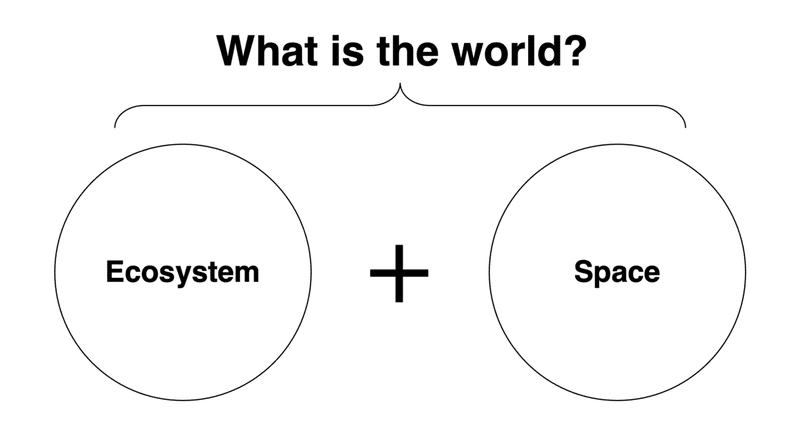
In this article, I mainly organize how to create the world as an "ecosystem". Finally, I will touch a little on how to create a world as a "space".
The World is a Complex Overlap of Ecosystems
We live surrounded by various ecosystems, large and small, and we perceive each of them as a single world.
For example, the largest world we know is the "universe," and the "society" and "nation" in which we live are worlds to the people who live in them, and the "company" and "school" are also worlds to the people who live in them.
There is a visible world like the "natural world", and there is also a world that exists only in virtual space like SNS.
The world of these ecosystems is very complex, yet organic like a living organism, and decentralized to the point that it can exist without a manager.
Is it possible to consciously design such a complex structure as an ecosystem, or is it just a product of chance? This has always been a personal interest of mine.
I asked one of my senior managers if it was possible to intentionally create this kind of ecosystem. I asked him if it was possible to intentionally create such an ecosystem, and he told me that such things are the result of chance and cannot be created intentionally.
What has always stuck with me, however, is that if these ecosystems are the product of chance, then people's daily activities are like gambling by continuously rolling the dice, and it feels empty.
Long ago, disasters and famines were thought to be the work of the gods, but with the advancement of science and the efforts of people, they have become understandable and can be predicted and countered.
In the same way, if we can consciously design these ecosystems, then people who want to create a better world will make efforts in the right direction and will be rewarded for their efforts.
I'm still in the middle of this project, but I'll try to organize the insights I've gained through my experiments so far.
Changing the World = Creating a New Ecosystem
Change the world, change society. We often hear phrases like that. If I had the power to do so, I would want to change the world, I think many people would answer.
The world here is exactly the same as "the world as an ecosystem," and "changing the world" means changing the structure of the ecosystem we live in.
It is a normal feeling to think that the world we live in has many problems and we want to improve it and make it better, but trying to do so is a very difficult task.
Conducting a coup like armed force to take over the leadership of the world would create a lot of misery and is unrealistic in modern times.
Political factions fighting each other by majority vote will leave a rift for the half of the people who don't agree with them, and they will continue to waste time and effort in mud-slinging and bickering. If you've ever seen political or corporate factions fighting, you'll probably agree.
So, what is the most effective way to change the world nowadays?
The shortcut to changing the world is to come up with a hypothesis for a new ecosystem and prove that it actually works.
If it is more efficient and benefits more people than the existing world, then it is hard to deny, and many people will want to join that ecosystem.
In the past, the world was tied to physical land, and people had to compete for the one and only land. However, most of the world today is just a social concept that is not connected to physical land. Companies, organizations, communities, and groups exist only in people's perceptions and are disconnected from physical space.
If this is the case, then those who want to change the current world only need to come up with a new ecosystem that overcomes the problems of the existing world and make it work in practice. It is more effective to recruit participants from the existing world by actually establishing the new ecosystem than to spend time and effort on fighting for the initiative.
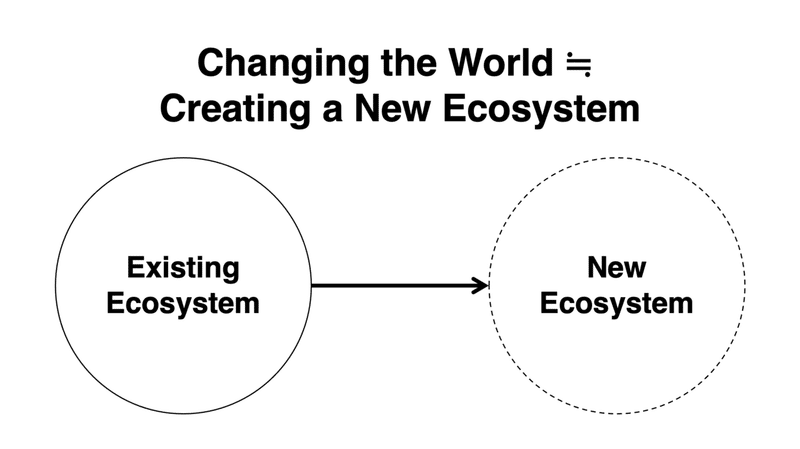
However, in order to do this, the know-how to establish a new ecosystem is very important. No one will take you seriously if you just shout your arguments out loud. If you want to make this world a better place, if you want to change the world, you need to learn how to create an ecosystem.
If you can understand the universal patterns that work regardless of whether there are 10, thousands, or tens of millions of people participating in that world, you can apply them to all aspects of society.
If you are running a business, you can apply it to product development, if you are a leader, you can apply it to maintaining your organization, and if you are running a community, you can apply it to revitalizing it. I think it is easier to understand if you think of it in terms of the various worlds (organizations, communities, environments, industries, services) in which you participate.
Features of well-run ecosystems
There are roughly three characteristics of a well-run ecosystem that exist in the world.
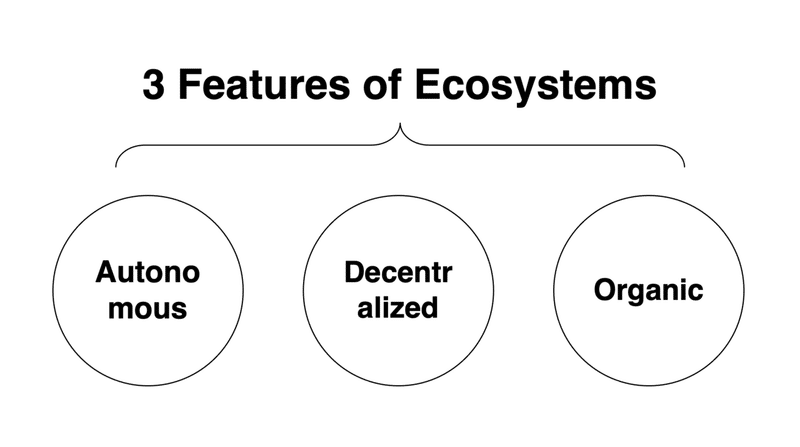
(1) Autonomous
A well-run ecosystem is autonomous. Without instructions or orders, individual participants can think and act on their own, and repeat improvements.
It is as if the group itself has a will of its own, rather than being directed by outside forces.
In order for this to happen, the participants of the ecosystem must understand the rules of the ecosystem and know what they are supposed to do within it.
(2) Organic
Next, it should be organic, as if each participant is working with each other to create an entire ecosystem.
For example, life is made up of an incredible number of cells that interact with each other, making it possible to move as a single organism. Similarly, ecosystems are formed as a whole by the interaction of each participant.
Communication is constantly taking place between each participant, and even when new people enter or leave, the ecosystem continues to move without losing its identity.
(3) Decentralized
The last word is a little difficult to understand, but it is decentralized. The opposite of decentralized is centralized, but this is easier to understand. The opposite of decentralized is centralized. On the other hand, decentralized means that the whole system continues to move without stopping even when there is no such command post.
One of the most successful ecosystems that we can directly observe is the "natural world". The natural world is autonomous, organic, decentralized, and there is no command post. There are always organisms being born and dying, and the participants are always being replaced, but the entire natural world continues to move unchanged.
Human society is like a degraded copy of the natural world, but over time, through repeated trial and error, we have gradually made its structure more complex and sophisticated. However, we have yet to attain the same level of complexity and flexibility as nature.
When creating an ecosystem with your own hands, it is best to keep the natural world in mind as your goal.
The instantaneous force of charisma, the inertia of ecosystems.
The quickest way to form a population that attracts a large number of participants is to have a charismatic person who attracts people.
A charismatic person with a strong vision, good looks and talent attracts people around him/her, and it seems like a shortcut to build a group around the charismatic person. However, this is a kind of doping. A group that relies on charisma can start up very quickly, but it has a weakness in that it is very fragile as a structure.
This is because the presence of the charismatic person is practically the greatest kryptonite of the group, and hitting this point can bring the group to a halt. The moment the charismatic has a scandal, collapses, loses motivation, withers talent, or loses appeal, the group is forced to cease to exist.
Therefore, groups that are supported by the centripetal force of a charismatic figure tend to be short-lived, and since the participants are dependent on the presence of the charismatic figure, it tends to be difficult for each individual to acquire the autonomy to think and act on their own to improve the whole.
In addition, while it is quick and easy to form a small initial group, it is difficult when you want to scale the population rapidly. This is because although you can attract people around you with similar attributes, it is very difficult to attract people with different values that you would not normally interact with. Therefore, the scale of the group is destined to be no larger than the charisma's fascination.
On the other hand, a group that is established as an autonomous, organic, and decentralized "ecosystem," as mentioned above, is the exact opposite of a group led by a charismatic figure.
It runs as a mechanism, and each participant has his or her own role to play, so that thinking and acting on one's own for one's own benefit leads to the prosperity of the whole.
Even if there is no charismatic person, the participants interact with each other like a network, so even if someone disappears, the group does not disappear at once. As a whole, the "force of inertia" works strongly, so the group continues to rotate without depending on anyone in particular.
On the other hand, the disadvantage is that it takes a long time for all the complex factors to be met before the ecosystem can run successfully.
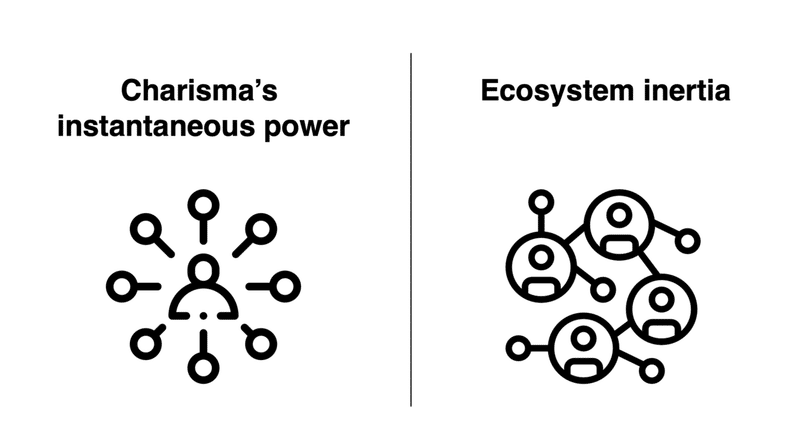
Great companies that have lasted for 100 years are also the result of being founded by a charismatic person and then "structured" so that they can continue to grow even in his absence.
However, charisma is not always essential in the early stages of a well-running ecosystem, and more often than not, the presence of charisma hinders the evolution of the ecosystem.
Therefore, the people who want to create a new world do not necessarily have to be charismatic themselves, and it is easier to promote evolution into an ecosystem from the beginning if they are not.
The role of ecosystems and types of values
Next, I will summarize the role of ecosystems as places and the types of value exchanged there.
An ecosystem can be simply described as "an environment where valuable things are exchanged.
Value here can be a physical thing like a product, or an intangible thing like information or images. Any ecosystem can be created as long as it is perceived as valuable by the participants.
For example, in the natural world, animals and plants exchange "energy" to live, in the consumer economy, "products and services" are exchanged, in the financial economy, "financial assets" such as stocks and real estate are exchanged, and in social networking services, "information" is exchanged to build an ecosystem.
The values exchanged in the ecosystem of "society" created by humans can be broadly classified into three types. There are three main types of value exchanged in the ecosystem created by humans: utility value, emotional value, and social value.
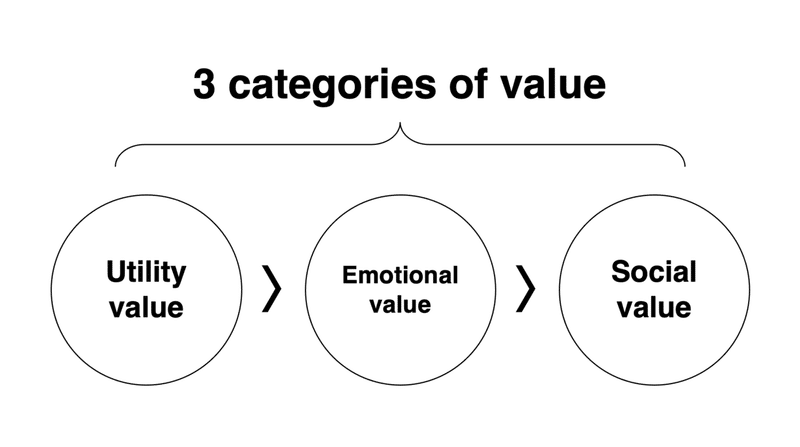
(1) Utility value
Practical value is the easiest to understand, and refers to goods, services, and information that are useful to participants in real life. It is the value that has real economic benefits, such as goods exchanged in the market, services provided in restaurants and hotels, and stocks and real estate exchanged in the financial market. Anything that is useful or profitable belongs to this category.
(2) Emotional value
Emotional value refers to rewards and values that have a positive impact on human emotions, although they are not directly useful or profitable.
It is very easy to understand when you consider what the entertainment industry deals with.
For example, music and live performances are not directly profitable to watch or listen to, but you would want to pay for them because they satisfy you emotionally.
In some cases, we go to a snack bar or restaurant because we want to meet the people there, and this can be said to happen because we see certain emotions as rewards, regardless of practicality.
(3) Social value
The last is social value. This refers to the fact that something that is beneficial to the entire group in which you participate is also perceived as valuable by the individual participants.
For example, even if voluntarism and donations do not directly benefit you, if they are beneficial to the order and prosperity of society as a whole, you will be willing to pay for them with your time, effort and money.
However, the magnitude of the three values mentioned above is not the same. (1) Practical value > (2) Emotional value > (3) Social value, in that order.
In terms of skin sensation, people should feel the strongest value in what is useful to them. Emotional value is hard to pay for unless you have enough food, clothing, and shelter to live a decent life. Volunteering and donations are also difficult to interest people unless they can afford it.
However, as the world gradually becomes more affluent, this distribution tends to slide to the right. The recent rise of crowdfunding and impact investing can be seen as a sign that the value of wanting to improve society as a whole is becoming stronger than the economic rationality of being useful or profitable.
Looking at the rise of the SDGs and environmental issues, it can be predicted that social value will become more and more important in the future.
Producers and Consumers
There are roughly two types of participants in the ecosystem who exchange this value.
One is the "value producer (supplier)," who creates and supplies the value mentioned earlier, and the other is the "value consumer" who buys, sees, hears, and evaluates the value.
The words "producer" and "consumer" here only mean "the one who creates value (producer)" and "the one who perceives value (consumer)," and are used in a broader sense than words like "the one who grows vegetables" or "the one who buys products.

For example, in the natural world where energy is exchanged as mentioned earlier, the "producers" are the plants that photosynthesize, and the animals that live by consuming them are the "consumers.
In a closer example, users who broadcast live on SNS, take beautiful pictures, or tweet interesting things are "producers" who provide valuable information, and users who watch, listen to, or comment on them are "consumers" who consume the information. Even in a salon or a circle, the people who think of plans are "producers" and the people who enjoy them are "consumers. Broadly speaking, the roles are divided into those who supply value and those who consume it.
In most cases, the number of producers is small compared to the number of consumers.
2 sides of the participants
The ecosystem becomes more robust when the participants have a duality that allows them to be either, depending on the situation, instead of being neatly separated into producers and consumers.
For example, in the real world economy, we are both producers, working for companies that make some products or provide some services, and consumers, buying products and receiving services when our work is done.
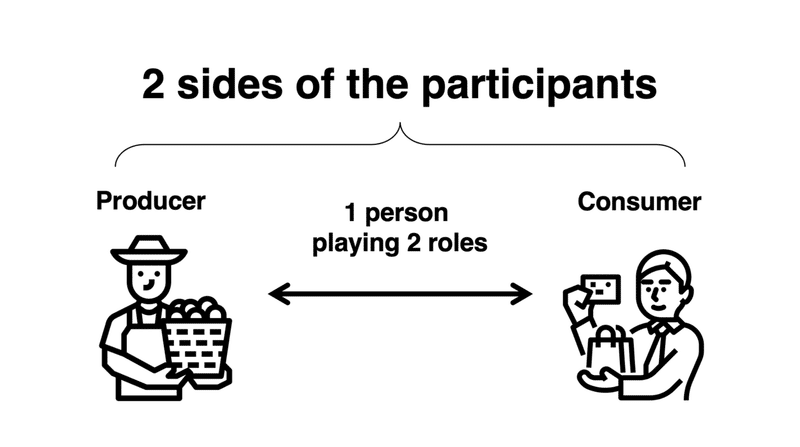
In many cases, people who sell things on flea market apps are also buyers, and people who send out information on social networking sites are both producers and consumers who see and hear what others are sending out.
In this way, the attributes of the participants are not clearly divided, and the roles of the participants change depending on the situation. As a result, one participant can play multiple roles, and the exchange of value becomes more active, and the ecosystem is strengthened.
The starting point of the ecosystem is on the "producer" side.
Although there are exceptions, the starting point for most ecosystems is the existence of "producers". The first hurdle is whether or not the producers of this value are willing to participate in the ecosystem, because an ecosystem can never exist unless there is value exchanged in it.
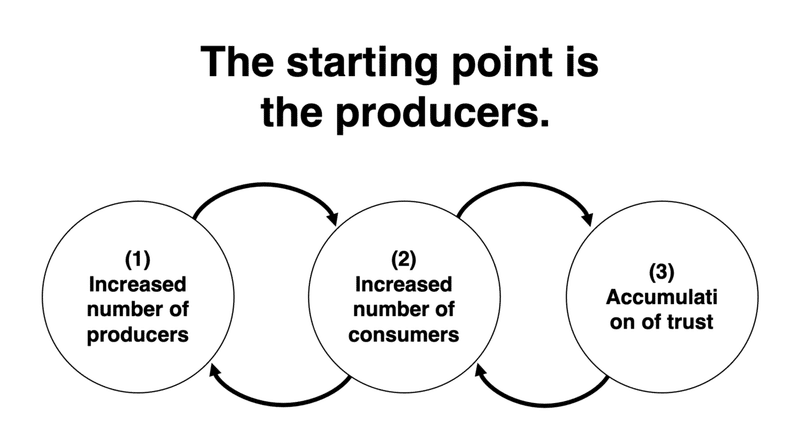
Even in nature, plants that produce energy through photosynthesis (producers) were born, and much later animals that consume energy (consumers) were born.
For example, no one wants to join a social networking site where no one is tweeting, and no one goes shopping at a shopping mall where there are no companies opening stores.
It is common for ecosystems to have producers who create value participate first, and then consumers are drawn to the value they create, and the order in which they gather and grow.
Chicken first? Egg first? The Question
Even though we know that we should get the producers first, the story is actually not that simple. This is because producers who create value will not participate unless there are consumers who will consume it.
For example, if you create a new service and ask a famous influencer to participate in it, there is no advantage for the influencer to participate in a service that few people will see. Influencers will not participate as producers and post valuable information unless they are paid a good price for it.
This is the famous dilemma of "chicken first or egg first". Consumers will not participate unless there are producers who can provide value, but producers will not participate unless there are consumers.
And because of the difficulty in solving this problem, it is difficult to create ecosystems, which are also considered to be "accidental".
However, while there is no perfect solution, some breakthroughs do exist based on many past examples. I will try to raise about four typical methods.

(1) Become a producer yourself and attract consumers.
The simplest approach is for the person who wants to create an ecosystem to become a producer himself, provide value and attract consumers, and then open up the environment to other producers.
Amazon is a typical example of this. Amazon has built up a huge customer base by renting warehouses and selling products to consumers as a seller of its own products, and then allowed other retailers to open stores on Amazon and sell their products freely.
The merits of this method are that (1) it is a quick and easy way to start up, and (2) since you are providing value as a producer, you can become familiar with consumer demand and share your know-how with other producers.
The disadvantage is that not everyone can continue their business while enduring huge losses like Amazon. There is a hurdle in that we have to question our own abilities as producers.
(2) Find an entity that can be both a producer and a consumer
One of the main reasons why the hurdle to establishing an ecosystem is so high is that we need to bring in two entities with different attributes, producers and consumers, at the same time.
If this is the case, there is a way to bring in participants who can play both roles at the same time, that is, who can be both producers and consumers. This is a common practice in Internet services where interactivity is important, and it is an ironclad technique in building social media and marketplaces.
In many social media sites, posters are also viewers, and in flea market apps, sellers sometimes become buyers.
When the initial participants, who are both producers and consumers of value, are included, an active ecosystem can be established even with very few participants. Once established, it will be possible to meet the demands of both sides even if only producers or only consumers participate.
One weakness is that this is not always possible depending on the genre. For example, there are cases where a high level of expertise or qualification is required on the producer's side.
For example, if you are thinking of creating a service that matches doctors with users, the user as a consumer can never play the role of the doctor as a producer. It becomes difficult when the attributes of the consumer and producer are too different.
(3) Provide information and tools that are attractive to producers first.
This is, in a sense, the exact opposite approach to (1). It is a method of attracting producers at once by distributing free information and tools that producers who create value first want.
In many cases, producers will give away free of charge things that are too cumbersome to do on their own, tools they wish they had, or information they feel they want.
The most famous example is Instagram. It is now the world's largest social networking service, but for those who have been using it since the beginning, Instagram was a photo processing application that allowed you to apply filters to your photos. People who wanted to make their photos beautiful (producers) started using it, and it became a social networking service by allowing other people (consumers) to see the photos they processed. For a long time, it was possible to process photos using paid software such as Photoshop, but Instagram started by providing free tools to people who wanted to do it easily from their smartphones.
(4) "Riding for free" on other ecosystems
It's a bit tricky, but there is also a way to grow yourself by taking advantage of the huge ecosystem that already exists.
In fact, there are times when other ecosystems enjoy the benefits of other ecosystems to a greater or lesser extent, but this is a method of deliberately going for it.
Airbnb, the famous home-stay service, is said to have found its initial success by hacking Craigslist, a local bulletin board, and automatically finding a shortcut to reach people who wanted to rent out their homes.
One of the weaknesses of this method is that it depends on other ecosystems, so if it is banned, it's over. It is also a rough method, so it can only be used in limited situations.
Work of an ecosystem designer
Even if producers and consumers were to come together successfully, this alone would not be enough to create an ecosystem. It is necessary for these two participants to exchange value spontaneously, and without some mechanism to do so, the ecosystem will disappear spontaneously. Those who design ecosystems need to provide the following functions for smooth exchange of value.

(1) Assistance in matching
As a matter of course, we need a system that encourages matching so that producers can supply value and it can properly reach consumers.
In addition, as the variety of value provided increases, the ecosystem will need a mechanism to make it easier for consumers to find products according to their preferences (improving searchability) and to recommend producers and value that match their preferences (implementing recommendations).
For example, Amazon always recommends products that consumers might want next based on their purchasing behavior. This eliminates the need for consumers to search for products and increases the frequency of value exchange.
(2) Visualization of trust
This is true for all ecosystems, but ecosystems absolutely need a mechanism to make the trust of the participants visible. Since new participants are always coming into the ecosystem, if you don't know if the people you are interacting with are really trustworthy, you will be too scared to move. It is also common for participants to be scammers or have malicious intentions.
Therefore, it is necessary to introduce a mechanism for participants to evaluate each other's behavior in the ecosystem. Then, we need to set up an index to visualize trust, and create a system that allows everyone to consider whether or not to interact with each other while looking at the index (introduction of an evaluation system).
When we actually buy something on the Internet, we look at the seller's reputation and word of mouth about the product to make a decision. Even in the real world, we make various decisions by trusting visual indicators such as the number of Michelin stars in a restaurant or the number of stars in a hotel.
As this trust information accumulates, it becomes easier for new participants to make various judgments, and the cost of decision-making decreases rapidly, and the exchange of value within the ecosystem becomes more active.
Furthermore, if a bad evaluation is given, it becomes difficult to operate in the ecosystem, which leads to the maintenance of order, which also serves as a deterrent to malicious behavior.
(3) Penalties for violators
How to deal with participants who do not keep their promises or act in a way that harms other participants is another task that ecosystem builders need to consider.
There is a saying that "the worse it gets, the better it gets", and this is true.
I'm sure many of you have experienced this before, but you don't want to go to an unsafe restaurant where the food is good but the people are rowdy. In an organization, if members who cause trouble to others are not blamed, the most capable members will quickly quit.
In the case of creating an ecosystem, clear rules must be established and followed by all participants so that they can trust each other and interact with each other.
A nation must have laws, a school must have rules, a community must have rules, and it must be well known that there will be penalties for participants who do not follow the rules, and that if they do not follow the rules, they will be asked to leave the ecosystem.
(4) Providing knowledge and tools to be able to help themselves.
One of the strengths of ecosystems is that the entire ecosystem thrives when participants make voluntary efforts, but it is also important to provide an environment that makes it easier for ambitious producers to achieve more.
Participants with diverse motivations come into the ecosystem, and while some are fine with the way things are, others want to develop their abilities and take advantage of more opportunities. For those producers who are ambitious and aspiring, we can help them with the logistics of their activities by creating programs to supply knowledge and know-how, or by providing them with tools free of charge.
The most obvious example is the education system of the modern state. The state provides compulsory education to its citizens and encourages them to raise their abilities by creating universities for each specialized field. Companies also provide special training programs for young employees who will become future executive candidates, or send them to study MBA abroad at the company's expense.
Ecosystems are viewed as a single life.
When producers and consumers come together, trust is visualized, value is exchanged smoothly, participants act spontaneously, and the entire ecosystem is thriving, it is also important to properly observe whether they continue to run well. If you've read this far, you'll understand that ecosystems can be thought of as a single life.
There is an overwhelming difference in structure between inanimate objects such as dust and stones and complex organisms such as plants and animals. There is a similar difference between a group of individuals and an ecosystem that has started to work well. It is said that life has the following characteristics.
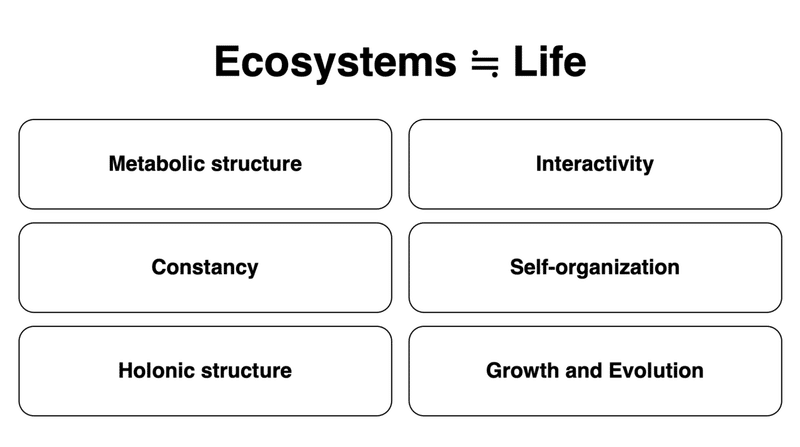
(1) Metabolic structure
A mechanism that takes in energy and circulates it. In ecosystems, it refers to a structure that exchanges and circulates values.
(2) Interactivity
An organic network in which cells interact with each other. In ecosystems, it refers to the mutual exchange of values and communication among participants.
(3) Homeostasis
An attribute that maintains identity through repeated metabolism and replacement of cells. It refers to the way an ecosystem continues to function even when new people join or existing participants leave.
(4) Self-organization
A phenomenon in which order is formed on its own as the amount of information increases. It is similar to the phenomenon where roles are naturally assigned and rules are formed as the number of participants in the ecosystem increases.
(5) Holonic and Fractal
A repetition in which parts make up larger parts, like a matryoshka doll. There are divisions, and divisions come together to form departments, and departments come together to form companies, and so on.
(6) Growth and evolution
It can change while repeatedly growing through metabolism and applying itself to the environment. It refers to the way in which an ecosystem matures as value is repeatedly exchanged, and changes to adapt to the external environment.
A life-like structure with these characteristics is called a dissipative structure. Ecosystems created by a vast number of participants have the same characteristics, and viewing them as life-like is a hint for observation.
Creating an ecosystem is similar to the act of raising a child and letting it stand on its own. It is important to frequently monitor the growth of the ecosystem and to periodically make adjustments if necessary.
How can we make the ecosystem more robust?
In order to make the ecosystem stronger, the following points need to be strengthened or supplemented.
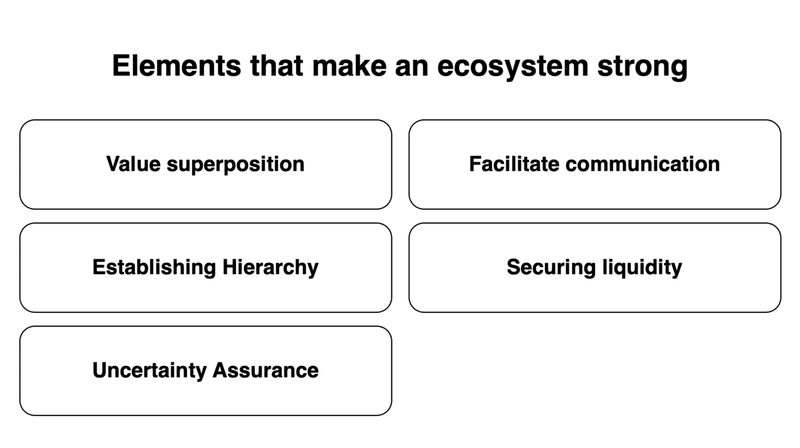
(1) Value superposition
We have categorized the values into three categories: practical, emotional, and social, but in reality, this may be vaguely felt by some participants and may combine two or three values.
Naturally, ecosystems that can exchange a variety of values are stronger and more solid. In addition, depending on the maturity of the ecosystem, the value being handled may change.
For example, a job that used to be done because it was profitable may change to a job that is done because it makes someone happy to be thanked, or because it is fun to interact with the people you meet there.
(2) Promoting communication
The more active the communication among participants, the stronger the ecosystem becomes and the more sustainable it becomes.
If participants can help each other when they have problems and ask each other questions when they don't understand something, they will be able to deal with problems on their own.
Ecosystem designers can promote the maturation of ecosystems by creating opportunities for participants to communicate with each other and devising ways to increase the frequency of such communication.
For example, in a company of a certain size, there is always an event such as a general meeting of employees or a launch, and in old villages and hamlets, there was always a place where everyone gathered for a festival or a ceremony.
(3) The Existence of Hierarchy
Hierarchy means "hierarchy" or "pecking order," and is a word that generally has a negative image, but its existence makes it easier for participants to communicate with each other and build relationships.
In each world, there is always an index that visualizes the hierarchy, and the relationships among the participants are built around it like a pyramid.
For example, if you carefully observe the real world and social networking sites, you will see that relationships are built around the deviation score for students taking entrance exams, the amount of assets under management for investors, the size of the company for managers, the number of subscribers for YouTubers, etc. In each industry, a hierarchy is created around a specific indicator, and relationships are created using the hierarchy as a starting point.
In other words, humans are creatures that naturally create hierarchies, because without them, the cost of estimating one's own position and that of others, and building relationships, would be abnormally high.
In an ecosystem with a huge number of diverse participants, there is no time or effort to think about who to talk to and what to say to everyone, so the construction of a hierarchy plays an important role as a starting point to encourage interaction.
(4) Securing fluidity (prevention of fixation)
It is important to ensure "fluidity" in ecosystems, where values are frequently exchanged, communication is active, and evaluations are updated in a short period of time. The higher the fluidity, the more active the ecosystem becomes; the lower the fluidity, the more stagnant the ecosystem becomes.
For example, if the position of the person who once has the upper hand is fixed, there is nothing for new participants to take advantage of. When this happens, the old participants will sit on their laurels and not make any effort, and new participants will not come in, so the entire ecosystem will become increasingly obsolete.
It is necessary for designers to observe whether all the fluidity in the ecosystem is maintained properly, and to analyze and deal with the factors that hinder fluidity.
(5) Ensuring Uncertainty
The last factor is uncertainty. Uncertainty is an instinctive characteristic of living things, and they are more focused and active when they are placed in an uncertain environment.
When humans were in nature, we were constantly exposed to natural disasters and the threat of being attacked by other animals, so we were always desperately trying to adapt to the environment and increase our chances of survival. Similarly, when the external or internal environment of an ecosystem is undergoing drastic changes, it is likely to become more active.
On the contrary, organisms that find themselves in an environment where there is no change will stop evolving and the ecosystem will gradually decline. In an ecosystem, it is good if it is designed so that there is a certain probability of something uncertain happening to the participants, such as frequent events, opportunities to come into contact with information that they would not normally see, or contact with participants who are far away from them.
Devices to attract individual participants
So far, we have mainly talked about the design of entire ecosystems, but there are also simple techniques to attract individual participants to the ecosystem. This is a little trick rooted in the instincts and brain mechanisms of living organisms, and is woven into various situations in the world. However, they are literally just techniques and cannot be the heart of the ecosystem, so it is better to have them understood as a kind of spice sprinkled at the end.
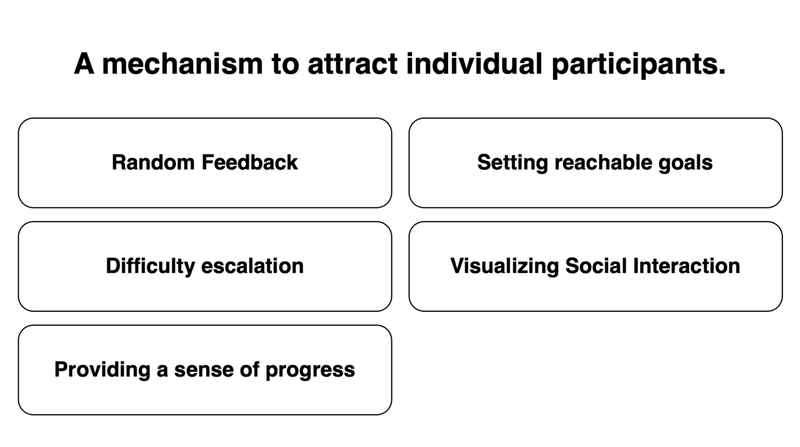
(1) Random feedback
One of the reasons why humans find games interesting is that people have a tendency to feel rewarded by their brains when the feedback (response) to their actions is uneven. This is a feature left over from the days when humans lived in an uncertain nature. Most games have this element in them, but they are also highly addictive, so be careful not to abuse them.
(2) Reachable goals
Humans have an attribute that if they are put in front of an achievable goal, they will want to do it. This is why it is important to always visualize your goals in detail, so that it is easier for you to continue and make the effort. Rather than setting high goals for dieting and training from the start, it is better to be presented with goals that can be achieved with a little effort.
(3) Escalation of difficulty
This is also similar to the reachable goal, but when the difficulty level of the task in front of us gradually increases, we have a tendency to become absorbed in it. I think everyone has a memory of playing a game that was easy at first, but became more and more difficult as you completed it, which was interesting and made you keep playing.
(4) Visualization of social interaction
We are social creatures, and we cannot ignore how we are viewed by those around us. Therefore, even if we can simply visualize that we are being watched by others, we tend to be curious.
For example, if the number of views or likes on a social networking site is visualized, we are more likely to go and look at it later, or if test scores are posted in the hallway, our motivation will change. If you can visualize that you are being watched, it will be harder for your consciousness to leave that place, so this can also appear in various aspects of your life.
(5) A sense of progress
Having a sense of gradual progress in your actions is very important to continue your actions. Designing a system that encourages people to accumulate small successes will help them gain confidence, which in turn will make it more enjoyable and easier to continue. this is also used everywhere for stamp cards for restaurant members, login back bonuses for social games, etc.
The above techniques can be categorized as gamification in the modern sense of the word, but they are only small techniques and do not create an ecosystem around them. Therefore, it is not recommended to put too much emphasis on it. It is better to remember that these are only to be added after the basic elements of the ecosystem have been captured.
The moment when ecosystems evolve organically
The phenomenon of one system turning into another, like water turning into ice, is called "phase transition," and it applies to ecosystems as well.
In general, work is about identifying and improving daily problems, and the results will follow in proportion. However, this is not the case in the construction of ecosystems. Unless most of the elements of an ecosystem are in place, even if you continue to make small daily improvements, the results will not be proportional to those improvements.
On the other hand, once the necessary and sufficient mechanisms are in place and the system begins to work well, it is as if the inorganic existence has suddenly changed into something else, as if it has suddenly transformed into organic life.
Once the ecosystem is established, the spontaneous interactions among the participants accelerate, and the ecosystem becomes autonomous. It's as if a being that never reacted to anything you did before has started running around and talking on its own.
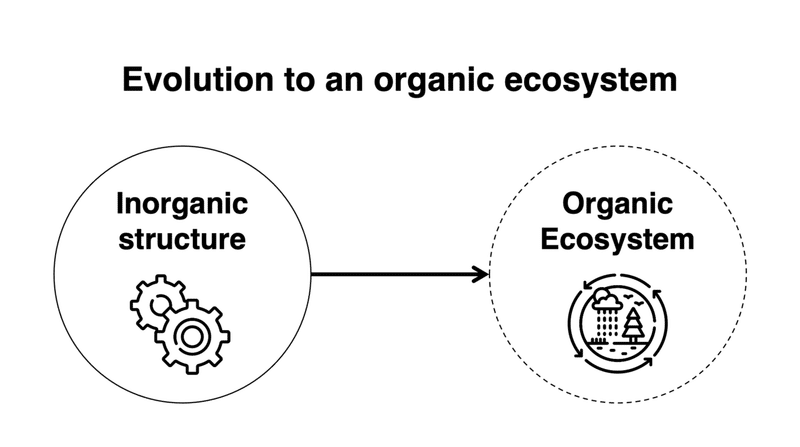
And the more the ecosystem matures, the more the designer's work gradually disappears, and eventually it becomes completely detached and begins to walk on its own. It is as if a toddler, who crying at night, grows up, graduates from high school, leaves home and starts living alone.
As the ecosystem begins to become autonomous, decentralized, and organic, it begins to grow exponentially, with each participant attracting the next.
In addition, the more value participants exchange, their credit is accumulated, and the cost of exchanging value among participants decreases rapidly.
This is the opposite of the chicken-and-egg problem, where producers attract consumers, and consumers attract producers.
In the end, the number of people participating in the cycle becomes the value of the ecosystem. This is called the "network effect" and ecosystems in which this effect occurs will exhibit powerful stability and inertia.
What's important in designing ecosystems
This is a summary of the basic structure of ecosystems and how they are created. This kind of talk may sound like a universal know-how that can be applied to anything, but in reality, it is not.
No matter how much knowledge you have, it is useless if you don't have an accurate grasp of the dissatisfaction and demand that people feel in the world, and it is also important that the times and timing mesh well.
And the most important thing is the human will to make the world a better place than it is now. This may sound like a wet mentality, but there is a structural reason for this.
As mentioned earlier, ecosystems do not grow linearly even after repeated improvements, but start to grow exponentially when all the factors mesh together. For this to happen, we need to keep improving forever, even if the days don't show any signs of success. You can't predict when it will come. It may never come.
If we only think about economic rationality, it will be a gamble that is not worth it, so in order to continue this, at least the people who are trying to create the ecosystem must have a strong will to make it work.
And this will cannot be borrowed from others.
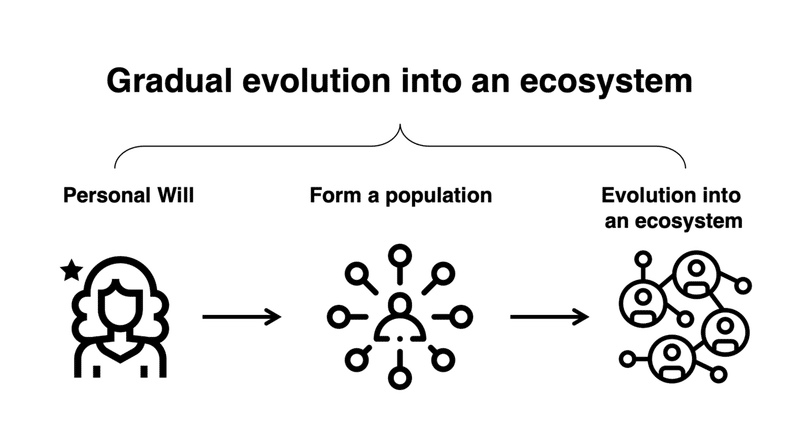
What makes it difficult to create a new ecosystem is that it requires at the same time the "will" of the designer to go beyond economic rationality, the "knowledge" to give shape to it, and the "patience" to keep improving it even if it does not produce results.
Building the world will be the future of work.
The last 100 years have been a time when the ability to think logically has been most valued. With the help of technology, we are now required in every situation to put phenomena that seem to be coincidental into logic and make them understandable.
In management, finance, organization, human resources, and sales, there is a need to think logically and to organize, predict, and act logically. This is where those who have been able to use technology and logic as their allies have gained great strength.
However, as a result of the fact that technology and logical thinking skills are now required as a matter of course in all industries, it has become difficult to demonstrate value on their own.
The modern age is called the age of VUCA, an acronym for Volatility, Uncertainty, Complexity, and Ambiguity. This is as irreversible as entropy in thermodynamics, and the faster globalization and technology advance, the more likely it is that this trend will intensify.
The more globalization and technological evolution accelerate, the more this tendency will increase, and the more the VUCA tendency increases, the more powerful ecosystems will become. This is because, as mentioned above, ecosystems are the very structures that are able to maintain their identity and homeostasis, flexibly adapting to drastic changes in the external and internal environments, and coming into their own in complex, unstable, and uncertain environments.
To use an analogy, an ecosystem is like a waterwheel that keeps going in a muddy stream where everything is being swept away.
As globalization and the evolution of technology continue to accelerate, it will not be enough to logically organize and improve things; we will need to be able to create ecosystems using technology and logic in every situation.
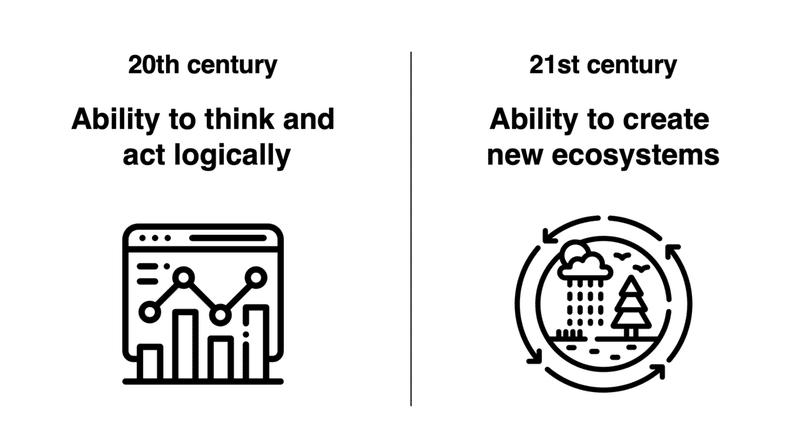
The ability to think logically means to predict the future based on an analysis of the events in front of you, based on objective facts, and to think of and implement actions that have the highest probability of success. In other words, it is the ability to abstract various events and then return the feedback to the real world in the form of concrete actions.
Creating an ecosystem, on the other hand, is about understanding the structure of the real world and then recreating the same thing as a concept. The ability to build ecosystems, which reproduces the entire structure of the real world, is a skill that is like a super-compatible extension of the ability to think logically, which decomposes the real world and improves parts of it.
As technology becomes more and more of a commodity, and logical thinking becomes an ability that humans take for granted, we will be required to have even more complex and difficult skills in order to demonstrate value in the next era. In the future, I predict that the ability to create ecosystems will become a skill that will be required of organizational leaders as a matter of course, not just special people who want to change the world.
The world as a "space" reflected in our eyes
Up to this point, I have used the word "world" in the sense of the world as an "ecosystem," but from here on, I would like to talk a little about creating the world as a "space.
With the spread of the Internet, the world as a concept that exists only in people's perceptions can now be easily visualized on the two-dimensional screens of computers and smartphones. Through social networking services and web services, we can recognize at a glance that a wide variety of ecosystems are being formed.
In the future, the spread of 5G and 6G will enable communication speeds that are tens to hundreds of times faster than current speeds, and the spread of VR and 3DCG will enable anyone to create a virtual world as a space.
And when we can live in virtual space at a level that is consistent with the real world, we can expect that "creating a world" will evolve to mean literally creating an ecosystem and space that resembles reality.
A myriad of multidimensional parallel worlds
Let's stretch our thinking further into the future from here. In the future, the communication environment will improve from 5G to 6G to 7G… As the communication environment continues to improve, and the computing power of computers continues to increase, we will be able to operate graphics of a quality that was previously unattainable in real time without stress.
The following video is a personal experiment in which I had AI automatically generate a 3D model of the ground by applying machine learning to earth observation data obtained from a satellite (reproduction of a certain area in central Tokyo). There is not a single real object in the video, everything is a virtual existence created by AI and 3DCG.
This is a bit technical, but the ground structure is automatically detected by applying machine learning to the still images of the ground and elevation data (DEM and DSM) available from satellites, and then a 3D model of the ground is automatically generated based on the algorithm. Furthermore, we used 3DCG technology to automatically reproduce the textures of stone, glass, steel, plants, etc., and connected them together as a single system. The accuracy is still low because it is still in the experimental stage, but theoretically, it is not impossible to automatically generate any landscape in the world as long as it can be observed from a satellite.
From here, I would like to let the AI learn all kinds of information about the real world and reconstruct the world in virtual space, and then distribute the 3D models of that world for free so that anyone can use them.
As these technologies become available to everyone, individuals will be able to immediately use them for free, instead of the dozens or hundreds of creators and engineers who used to gather and create them in a few months.
In addition, as devices such as VR become more widespread, it is easy to imagine a future in which people can create a virtual world with a quality that gives the illusion of reality as easily as creating a social networking account, recruit friends, and conduct various activities on a daily basis. I have a feeling that the world view of the movie Matrix or Ready Player One is just around the corner.
Furthermore, since blockchain technology and other technologies make it possible for assets in virtual space to exhibit scarcity value, in the near future it will be much easier than now to convert the world you have created into value.
For the next generation who grew up watching YouTube since they were babies, it will be a breeze to use game engines such as Unity to create their favorite virtual worlds and play with their friends.
Today's adult generation, including myself, knows the time when the Internet did not exist and physical space was the only world we had and we were fighting for it. As a result, we modern people are imbued with a kind of habit of thinking about something in two opposing structures.
For example, we tend to divide ourselves into factions and bicker with each other as if we are fighting for territory, and we tend to attack those who disagree with us and try to settle things in black and white. This is the style of the times when we have been fighting each other for the one and only physical world of "land".
For the generation that is now able to freely create worlds in the infinitely expanding virtual space, it is natural to recognize that the world is not one like the physical space, but a multitude of overlapping and parallel worlds, each of which can expand a diverse ecosystem without mutual interference.
As the generation that can accept such a diverse world becomes the mainstay of society, the social status of those who have traditionally been looked down upon as minorities will continue to improve, and the idea that "there is no need for confrontation and that different worlds can exist side by side" will become a common sense of value.
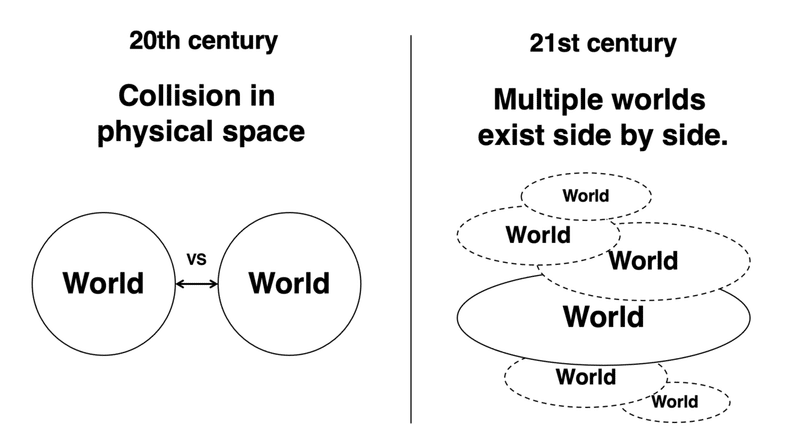
One of the hypotheses of the universe in physics is the concept of "multiverse," which is the idea that the physical universe we live in is not one, but multiple universes existing in parallel.
In the same way, I expect that the world as we perceive it will become closer to an image in which various worlds spread out in all directions, and expand infinitely while overlapping in parallel.
In the future, multiple "worlds" will be created in parallel, and it may become common for individuals to use multiple "personalities" for each world. Even today, people are beginning to use different personalities for the real world and for social networking sites, and they are also beginning to play different characters on different social networking sites such as Twitter and Instagram.
The word "individual" is a combination of the words "in" (negation) and "dividual" , meaning "the smallest unit of existence that cannot be divided any further", and refers to the "individual".
In the future, individuals will be using multiple personalities across multiple worlds, so the etymology of this word may no longer match the times.
Beyond the virtual world, which is more attractive than the physical world
Technology has evolved to the point where it can no longer just make the real world more convenient, but can create the world itself, and has become so big that it demands a redefinition of society and people. From now on, we will enter an era in which human imagination will be expanded infinitely.
I have titled this article "Part 1", but I have not yet written the second part. This is because there are still many things I don't understand about how to create a world as a space, and I am still in the middle of experiments.
How humans see the world as a space, what they perceive as reality and what they perceive as fake, is as deep and interesting a theme as designing an ecosystem, and I am constantly making new discoveries and realizations.
If I hadn't thought about creating a world, I wouldn't have cared at all about how I see this world. In the sense that what I wanted to know was actually in my own perception, I was truly in the dark under the lamppost.
If I ever write a second part, it will be after I understand how to create both"the world as an ecosystem" and "the world as a space.
I wonder what kind of future awaits us when anyone can create a virtual world that is more attractive than the physical world we live in by merging ecosystems and spaces. I would like to write about this in the second part of this article. And I would like to enjoy the process of getting there as much as I can.
At the end
I'm ashamed to say that I used to think that with a strong will, I could change the world and make anything happen. Of course, that was not the case. There are things that are beyond the control of an individual's will. I was so desperate about this that I spent a long and lethargic time by myself. This is because the ideal of how we want the world to be and the reality of how the world works are completely different and unrelated.
What I felt to be the greatest power beyond the reach of individual will was the power of the ecosystem in society. Society continues to rotate regardless of the ideals of the individual. There is a powerful inertia (inertia) at work in society, so powerful that it can drown out the slightest individual intention. It is a force that says, "This is how the world works, and it has always worked without problems, so it should continue to work that way.
I thought that if I could learn about the power of ecosystems, which transcends the will of the individual, and if everyone could use it, I might be able to see a different view, and I continued my trial and error on the theme of how to create the world.
When you hear the words "design an ecosystem," you may think of an unhurried task as if you were solving a mathematical equation logically, but in reality, it is a series of days that test your will as a human being.
The act of trying to create an ecosystem is a very human act, where you have to endure the days of not being able to see any results, endure the doubts, ridicule, and misunderstandings of the people around you, be happy and sad with the reactions of the participants, and groping your way through the darkness, believing that one day it will take shape. In order to continue this, a will beyond profit and loss is required.
For this reason, I think it is difficult to create a new world for people who are dominated by economic rationality, obsessed with resignation, and have lost their ideals and will.
This repetition of human activities was unexpected for me, as I was expecting something mechanical and inorganic laws.
However, in the end, I realized that the human will to create a better world than the one we have now is what is moving this world forward, and while it was strangely funny to think that I had come full circle from will to logic to will, I was filled with joy for some reason.
I had given up thinking that there was nothing an individual's small will could do for this huge world, but I felt like I was taught that this was not the case.
As a reminder to myself, I would like to leave you with a phrase that I personally like from Einstein.
Imagination is more important than knowledge. Knowledge is limited. Imagination encircles the world.
The more knowledge and experience we have, the smarter we become, the more we tend to think we know everything, and the more we stop imagining. However, in today's world, things are changing so fast that the knowledge of the past will soon expire.
Although it may seem irrational and foolish, I believe that we can get closer to the truth of this world if we do not depend on what we have accumulated so far, but always challenge the unknown, struggle daily, fail, get hurt, suffer shame and despair, and come into contact with the raw reality. It is much harder to remain foolish than to be wise. I strongly believe that I want to continue to be foolish.
This is a record of my personal experiments and thoughts up to now, but I hope that someday, somewhere, it will catch the eye of someone who wants to change the world or create a new world, and that it will be useful in some way.
・Español: La creación del mundo (Parte 1)
・Deutsch: Wie man eine Welt erstellt (Teil 1)
・Français: Comment créer un monde (1ère partie)
・Português: Como criar um mundo (Parte 1)
・简体中文:如何创造世界 (第一部分)
・한국어: 세계를 만드는 방법 (전편)
・日本語:世界の創り方(前編)
